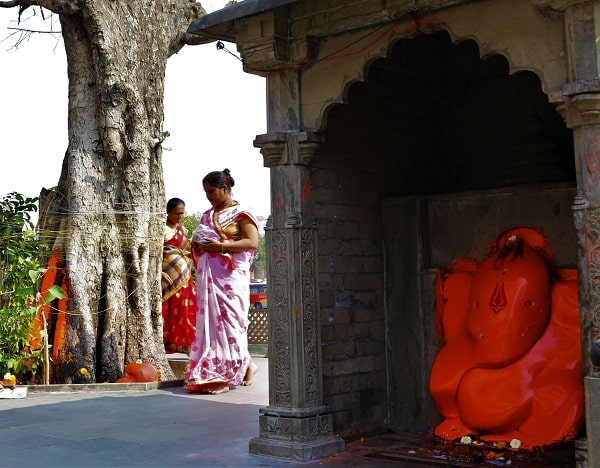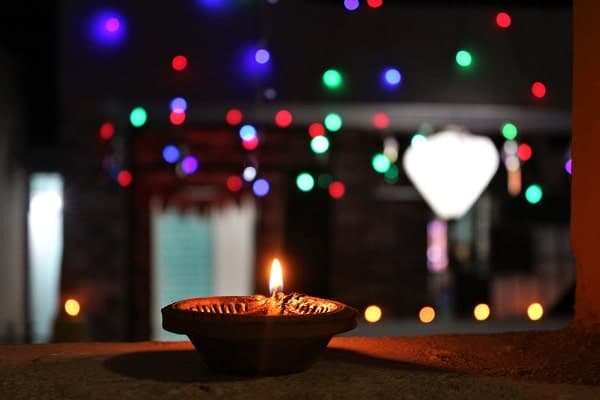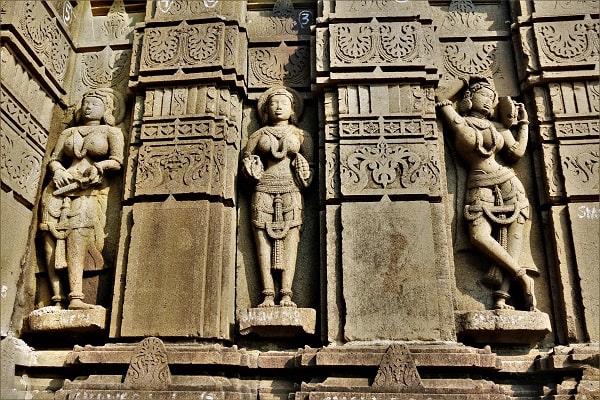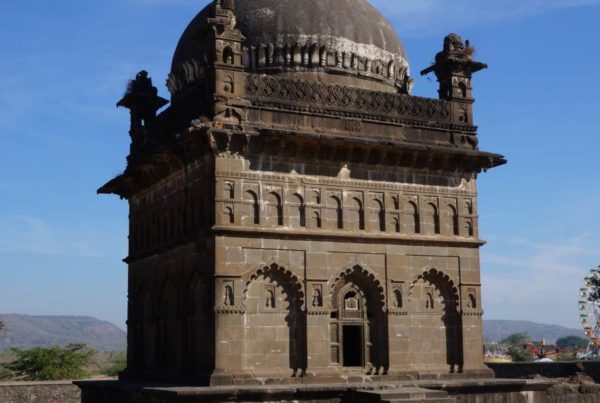India is the only country in the world to have seen the creation of 4 religions on its territory: Hinduism, Sikhism, Buddhism and Jainism. You must be wondering what the relationship between women and Indian religions are.
The women in Hinduism
Hinduism is the main religion in India. It is practised by about 79% of Indians. It is also one of the oldest religions in the world. That is the mother of other religions born in India. It is a relation which determines the relationship between women and Indian religions.
Women are important element in the society
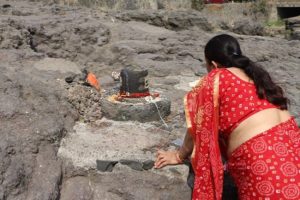
When you share the daily life of an Indian family for a few days, you will be surprised to see that it is the housewife who does the daily rituals. Likewise, she is the one who conduct domestic ceremonies during major religious festivals. Finally, she is the one who welcomes new arrivals with warm Pujas. One might therefore think that woman is a central element of Hindu spirituality. As is often the case in India but it is much more complicated than that.
Protected status of women in canonical texts
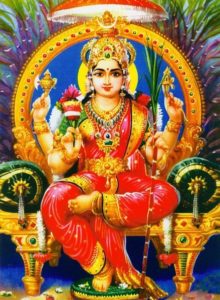
Parvati
There are two sets of important texts in Hinduism: the Vedas and the Manusmurti.
They are also called Manav- Dharmashastra which is a law treaty of the second century BC. In French, we know it under the name of Law of Manu.
This text includes different rules that apply to women. Some are in favor of it, others are not.
It is clearly stated that mistreating a woman anger the Gods.
“Who despises a woman despises his mother. The tears of women attract the heavenly fire to those who make them flow”Law of Manu.
Another reference text is the Kama Sutra. It is attributed to Vatsyayana. It explains that female desires must be respected. So does its necessary fulfillment. In this text, there is a clear rejection of forced marriages. Indeed, the physical act can only be done after an intellectual conversation between the two partners.
“A young girl will never be fulfilled if the parents forced her, out of greed, to consider a wealthy man as her husband, without worrying about his appearance and his qualities. If he is poor and insignificant but filled with better qualities, sometimes parents prefer to get married their daughter to great merit guy who has many wives. “- Kâma-Sûtra, III-4.
But woman remains in the service of man
In Manu’s Law, there are also passages which make it clear that a woman has no destiny other than that of serving her husband.
“Although the conduct of her husband is blameworthy, although he engages in other loves and is devoid of good qualities, a virtuous woman [sati] must constantly venerate him as a God”
We see here that the woman must accept everything from her husband. The text goes further by saying that her husband is her god. It also means that whatever a man does, he will always be superior to his wife and to women in general.
In another passage, it can be seen that women do not have the right to free will. She must always obey someone.
“A little girl, a young woman, a mature woman, must never do anything on their own authority, even in their house. In childhood, the woman must be dependent on her father, in young age, on her husband, and if her husband is dead, on her sons; she never enjoy independence”.
Finally, if the husband is sterile, the men in the family can have physical relation with that woman for growing their generation.
“When one has no children, she can be served as productive by the permission of herself and parents but these women who are widow or without children can only have one baby.” This passage does not clarify who are responsible for this.
The south India exception
In South India, as per Vaishnav (believers of Vishnu) texts, women are considered more privileged than men.
Children get the name of their mother in family name, they also have rights to ask for properties in maternal side.
The role of women in modern India in the 19th century
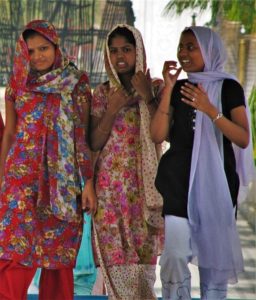
There were reforms that allowed women to be priests. Even though it’s quite rare, there are examples of important women in Hindu spirituality.
The best known is undoubtedly Mata Amritanandamayi. She is widely known as Amma. Since 1975, she has been organizing ceremonies and teaching about love, respect and ecology.
As I often say, India is a complex country. Even if the majority religions are unfavorable to women, the Indians obtained the right to vote before the French. India has also become the first modern country to be lead by a woman, and many women have had important political roles.
The woman in Sikhism
Sikhism is a religion born in the 15th century in Punjab in the north of India. This religion is found halfway between Islam and Hinduism. Its founder Guru Nanak has originally talked about the important role of women in this new religion.
The woman according to Guru Nanak
From the start of Sikhism, Guru Nanak proclaimed equality between men and women. Women are therefore fully authorized to participate in all religious activities of the Gurudwara (temple). They can sing and make the hymns sing to the faithful. They even have the right to command an army in war time.
He objected to treating women as unclean when they are menstruating.
In 1499; he declared that “the woman perpetuates the race and therefore we cannot consider women the accursed and condemned [when] the woman is born leaders”
And for others gurus
Sikhism has 10 human gurus and Now Guru Grant Sahib, the sacred book is called as last guru of Sikhism.
Amar Das, the third Sikh guru, spoke out against wearing the veil for women. He also commissioned several women to oversee communities of disciples. Amar Das opposed the practice of Sati (suicide of the widow at her husband’s funeral). Finally, he fought regarding infanticide of female newborns.
Gobind Singh is the last human guru in Sikhism. He is buried in Nanded, Maharashtra. He instructed the community of believers, the Khalsa, not to associate with those who preach against women. Also, he strongly stood against to the woman who being treated as an object.
Women and Indian religions: Guru Grant Sahib
The sacred book of the Sikhs contains all that we have just mentioned. It is therefore written on stone, the important place of women in Sikh society.
“From woman, man is born; in women, men are conceived; to the woman he is engaged and married. The woman becomes his friend; through women, future generations come. When his wife dies, he seeks another woman; to the woman, he is related. So why call it bad? It is from them that kings are born. From woman, woman is born; without a woman there would be no one at all. ” – Guru Nanak, Raag Aasaa Mehal 1, Ang 473
“Any other dowry that the voluntary manmukh offer for the marriage is nothing but false selfishness and worthless display. Oh my father, please give me the Name of the Lord God as a wedding gift and dowry. ” – Sri Guru Granth Sahib page 79
“Do not call them Sati”, who burn themselves with the corpses of their husbands. Oh Guru Nanak, they alone are known as “sati”, dead from the shock of separation. … Some get burned with their dead husbands: [but they don’t need it, because] if they really loved them, they would endure living pain. ” – Sri Guru Granth Sahib page 787
The reality of women in modern Sikhism
A religion is never free from its cultural basics of birth. Despite advances in the status of women in this religion from the 15th century, the reality is different.
This is what this incident in 2003, which occurred in the Golden Temple of Amristar shows. Two women wanted to perform a ceremony and were prevented by men. Even though, since 1996, there have been no restrictions for women. The Sikh religion is tinged with patriarchy like any other religions.
Women and Indian religions: in Buddhism
The question of women in Buddhism is quite complex and diverse.
Women and the Buddha
Siddartha Gautama, the historical Buddha, was raised in a harem in the presence of many women. When he decides to leave the palace, he abandons his wife, Yasodharâ and his newborn, Rahul.
He began his spiritual journey with very harsh acetic practices. When he decides to stop these practices, it is a woman, Sujata who offered him his first meal.
After reaching enlightenment, it took 5 years for the first women to enter the Sangha, the monastic community.
Women in the Sangha
The first one to open the debate on the entry of women into the monastic community was Sariputra (Sariputtara). He is the main disciple of the Buddha. When Siddartha’s adoptive mother wants to become monk, he refuses. Faced with this, Sariputra asks for explanations. The Buddha declared that bringing women into the Sangha will kill his teachings after 500 years while without them; they will live for 3000 years. Sariputra discussed many things with the Buddha for a long time. He succeeds in convincing him. However, women have more rules to follow than men when they become nuns.
The evolution of the place of women in Buddhism
In current Buddhism, there are three types: the Theravada, the Mahayana and the Vajrayana.
In the Theravada:
This current type is the orthodox of Buddhism. It applies the precepts of Buddha to the people without interpretation. It is in Thailand, Cambodia, Laos, and Burma.
For them, a woman can reach enlightenment but she will need reborn in a man’s body in order to be able to exit the cycle of rebirths or samsara. In northern Thailand, many temples are closed for women. The nuns are quite rare and the great masters are generally men.
In the Mahayana
Before his death, the Buddha said: “I have shown you a way; it’s up to you to find yours”. It is this sentence which formed the origin of the Mahayana Buddhism. This introduces the figure of the bodhisattva, that is to say a being who is at the gates of awakening but who refuses nirvana to be reborn and guide all beings to reach awakening.
Many female figures appear in the Mahayana. For example, the female version of Avalokiteshvara, the bodhisattva of compassion is Guanyin. Despite everything, the nuns still have a secondary role and more obligation than the monks.
In the Vajrayana
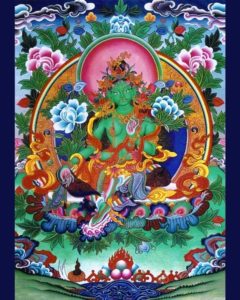
Tara
It is the esoteric version of Buddhism. Vajrayana is widely known, thanks to Tibetan Buddhism.
In this one, the place of the woman is important thanks to the figure of Tara, a central bodhisattva in the rituals. It is necessary to wait for the XXth century in order to see women taking a more important place in the Vajrayana. The XIV Dalai Lama, Tenzin Gyatso, canceled the additional vows of the nuns. Now monks and nuns have the same number of vows to make when they join the monastic community. He even announced that there was no obstacle for the next Dalai Lama to be a woman.
Since the 15th century, Samding Dorje Pakmo Trülku is the third in the hierarchical order of the Gelugpa school after the Dalai Lama and the Panchen Lama. All of his reincarnations were women. Currently Dechen Chökyi Drönma is the twelfth reincarnation of Samding Dorje Pakmo Trülku.
Women and Indians religions: in Jainism
Jainism was born almost at the same time as Buddhism. It was born in Bihar and Jainism was found in Gujarat. These two movements were created in reaction to Brahmanism and its excesses. Jainism focuses on Ahinsa or nonviolence.
What the texts said
The sacred Jain texts in no way mention the gender of the believer. We are all equal when faced with the path to liberation. This is because we recognize that every living being has the right to an egalitarian existence.
There are many religious and cultural figures described as goddesses and in the legends of the Jinas, many women have played important roles. The “Sola Sati” or the sixteen virtuous women highlights exemplary religious qualities and are imitated as great roles by Jain women.
And in practice
There are two types of thought in Jainism: the Digambara school and the Svetambara school.
To achieve total renunciation, one must practice Moksha. That is to say, give up all your clothes and live completely naked.
For the Digambara School, a woman cannot reach this level and must therefore be reborn as a man in order to complete her spiritual journey.
For the Svetambara School, this is not necessary. A woman can achieve liberation in her womanly life. It is because practitioners are allowed to wear clothes even during Moksha that this school allows women to achieve enlightenment.
Many Jain consider women to be inferior, and since their nature is to take care of children, they are unable to give up and therefore achieve liberation.
Here is a small overview about women and Indian religions.
The basics of the status of women in India is addressed by the Travel Jatra community group. If this or any other topic interests you, you can learn more about the Jatra community.

